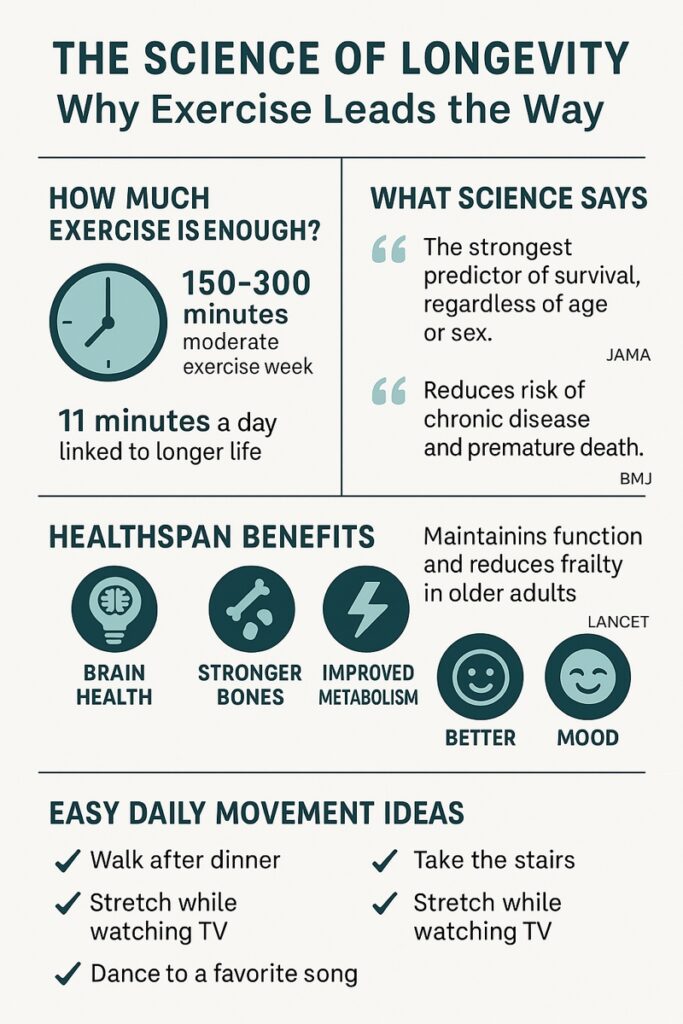More Than Living Longer—Living Better
What if the most effective ‘longevity pill’ is already within your reach—free, accessible, and scientifically proven? That pill is exercise. Across decades of research, no single lifestyle factor has consistently matched the benefits of physical activity when it comes to aging well. Exercise and healthy longevity go hand in hand.
Exercise doesn’t just add years to your life—it adds life to your years. The latest science shows that regular physical activity improves not only lifespan but also healthspan—the number of years you live free of chronic disease, mobility loss, or cognitive decline.
The Science Behind the Claim
The evidence is robust. A recent 2025 meta-analysis —across 32 studies—that examined over 6.5 million participants found that consistently consistently active peoplein adulthood had approximately a 30–40% lower risk of dying from any cause compared with those who remained consistently inactive.
A study from the Cleveland Clinic on aerobic fitness and longevity found that the more cardiorespiratory fitness you have, the longer you’re likely to live. In fact, people with the highest levels of aerobic fitness—especially those over 70 or with high blood pressure—saw the biggest benefits.

How Does Exercise Improve Longevity?
Exercise and healthy longevity are deeply connected because movement benefits nearly every biological system in the body. It helps reduce inflammation, improves blood sugar regulation, lowers blood pressure, and supports healthy weight management. Regular activity is also associated with higher bone density, better mental health, and reduced risks of cardiovascular disease and cancer.
From a cellular perspective, physical activity enhances mitochondrial function and slows telomere shortening—two markers of aging at the molecular level.
The Power of Movement—What Counts as Exercise?
The World Health Organization guidelines for physical activity recommend at least 150 minutes of moderate-intensity aerobic activity or 75 minutes of vigorous-intensity activity per week, along with muscle-strengthening exercises on two or more days.
Even short, consistent bouts of movement—like brisk walking, stair climbing, or strength training—deliver measurable benefits. It’s not about doing more; it’s about showing up regularly.
Exercise as a Tool for Healthspan, Not Just Lifespan
The benefits of physical activity extend far beyond simply adding years to your life—they also enhance the quality of those years. Studies consistently show that people who stay active are more likely to maintain their independence, cognitive sharpness, and emotional well-being.
The Harvard Study of Adult Development, one of the longest-running studies on aging, identified physical activity as a key predictor of healthy aging. Likewise, a 2022 review in The Lancet Healthy Longevity found that regular exercise reduces frailty and supports physical function in adults over 60. Staying physically active is also critical for preserving the functional abilities that enable healthy aging.
Why Exercise Stands Out Among Other Longevity Habits
While habits like good nutrition and stress management are important, exercise is unique in its ability to improve nearly every system of the body. It boosts cardiovascular health, strengthens muscles and bones, supports metabolism, reduces inflammation, and enhances brain health.
According to the National Institutes of Health, exercise positively impacts aging biomarkers such as mitochondrial function and immune response. A 2021 article in Frontiers in Aging Neuroscience reported that regular exercise also reduces the progression of neurodegenerative diseases and supports mental health into older age. These findings are echoed by more recent studies, which also highlight the role of exercise in enhancing neuroplasticity—the brain’s ability to reorganize its structure, functions, or connections. This adaptability plays a critical role in delaying or modifying conditions such as Alzheimer’s, Parkinson’s, and other neurodegenerative diseases.

From Knowledge to Action—Make It Stick
Consistency doesn’t mean perfection. Start where you are:
– Take a 10-minute walk after meals.
– Stretch for five minutes each morning.
– Dance to a favorite song.
Every step counts. The key is to build a routine that fits your lifestyle—so you’re not relying on motivation, but on momentum. If you’re looking for ideas to get started safely, explore these safe and effective exercises for all ages to find movements that meet you where you are.
The Best Investment You Can Make
If you’re looking for one change to extend your life and improve its quality, let it be this: move your body.
Exercise is the most evidence-backed prescription for a life well lived—not just in years added, but in strength, clarity, and emotional well-being preserved. Start today, start small, and stay with it. Your future self will thank you.
Ready to add more healthy years to your life?
At Pledge To Fitness®, we design personalized programs to help clients of all ages move better, feel stronger, and live longer in good health. Whether you’re easing back into fitness or aiming to elevate your long-term health, the key is consistency—and making smart, sustainable choices.
Book a free consultation—online or in person—and start building the habit that research shows can be life-changing: moving your body with purpose.
FAQ: Exercise and Healthy Longevity
Q: What type of exercise is best for healthy aging?
A: A combination of aerobic activities (like brisk walking or cycling) and strength training (like resistance exercises or weight lifting) offers the greatest benefits for healthy aging. These activities support heart health, muscle mass, and mobility—all crucial for longevity.
Q: How much exercise do I need to live longer?
A: According to the World Health Organization, adults should aim for at least 150 minutes of moderate-intensity aerobic activity (like walking) or 75 minutes of vigorous activity (like running) each week, plus two days of strength training.
Q: Can exercise really increase your lifespan?
A: Yes. Multiple studies show that regular physical activity is linked to a lower risk of all-cause mortality. One large meta-analysis found that people with high physical activity levels had a 73% lower risk of premature death compared to those with low activity levels.
Q: Is it ever too late to start exercising for longevity?
A: It’s never too late. Research confirms that even starting exercise in your 60s or 70s can reduce the risk of disease, improve quality of life, and increase lifespan. The key is to begin safely and stay consistent.
Q: What is healthspan, and how does exercise improve it?
A: Healthspan refers to the number of years you live free of major chronic disease or disability. Exercise improves healthspan by reducing the risk of conditions like heart disease, diabetes, and cognitive decline—allowing you to stay active and independent longer.



